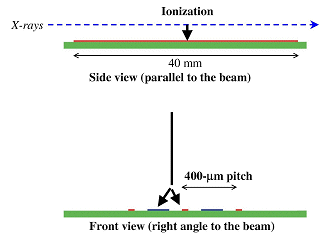MSGC operation
The MSGC detector is intrinsically a "curved" detector thus avoiding parallax problems, due to the large X-ray absorption length in a gas chamber, when X-rays are not impinging at right angles onto the detection surface. The strip pattern consists of 1024 10-mm wide anode and 90-mm wide aluminium cathode strips of 1 mm thickness printed on 0.4-mm thick D263 glass plates. The spatial period of the strip pattern is 400 mm. All the anode strip electrodes point at the sample position placed at a radius of 360 mm from the inside edge of the 40-mm long anode strips. The distance between the drift electrode and the glass plates is 10 mm. X-rays from the sample propagate through the drift space parallel to anode strips and the surface of glass plates. The 8-mm wide detector entrance window is covered with aluminized Mylar film. The detector has a total acceptance angle of 60° with an ultimate angular resolution of nearly 0.03°. Depending on the X-ray photon energy used, the detector may be filled with different gas mixtures of Ar/DME or Xe/DME. The following figure shows the operational principle of the detector.
 |
| MSGC detector operating principle |
In the detector, a negative potential is applied to the drift electrode. The anode strips are grounded via the DC connection to the preamplifier. Each anode strip is individually equipped with a charge sensitive preamplifier-shaper, discriminator and scaler. The rear edge of the strips is wire bonded to the electronics.



